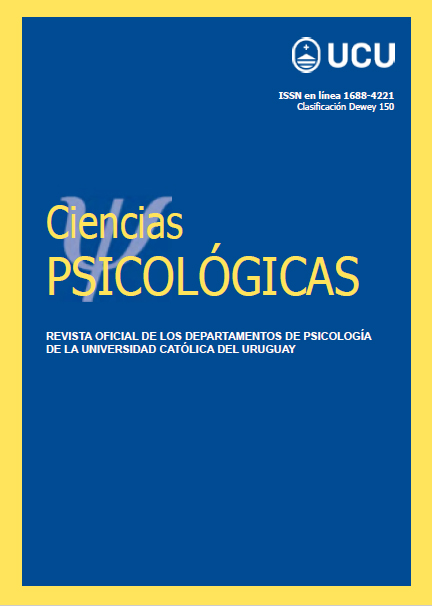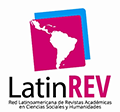Anti-bullying interventions with adolescents: a mapping review
DOI:
https://doi.org/10.22235/cp.v19i2.4658Keywords:
school psychology, school violence, adolescence, interventionAbstract
Bullying and cyberbullying are problematic group phenomena that affect adolescents' health and development. This study aimed to systematically identify and describe the content of anti-bullying interventions conducted with adolescents. To achieve this objective, a mapping review was conducted following PRISMA guidelines and searching the SCOPUS, PsycINFO, PubMed, and Web of Science databases. A standardized data extraction form was developed, and all results identified in the consulted sources were exported to the Rayyan platform. All titles and abstracts were reviewed in the first screening stage, followed by full-text retrieval for corpus formation. Data were analyzed descriptively and analytically. Eleven studies were included in the review, reporting ten interventions. A diversity of components and theoretical foundations was evident across the reviewed interventions. All documented initiatives were effective, to some extent, in addressing bullying and/or cyberbullying. Student participation in leading peer-based intervention activities was highlighted in some cases. Culturally relevant interventions were documented, and participatory approaches integrated into the school environment were highly valued, serving as inspiration for future initiatives.
Downloads
References
Ansary, N. S. (2020). Cyberbullying: Concepts, theories, and correlates informing evidence-based best practices for prevention. Aggression and Violent Behavior, 101343. https://doi.org/10.1016/j.avb.2019.101343
Aristimuño, A., & Noya, J. C. (2015). La convivencia escolar y el fenómeno del bullying en la enseñanza secundaria de Uruguay: un estudio de caso. Páginas de Educación, 8(2), 36-65. https://doi.org/10.22235/pe.v8i2.691
Best, O., & Ban, S. (2021). Adolescence: physical changes and neurological development. British Journal of Nursing, 30(5), 272-275. https://doi.org/10.12968/bjon.2021.30.5.272
Bosa, M. R., Bohórquez, M. C. C., Olarte, C. F. P., & Malaver, J. K. S. (2018). Diferencias por sexo en la intimidación escolar y la resiliência en adolescentes. Psicologia Escolar e Educacional, 22(3), 519-526. https://doi.org/10.1590/2175-35392018039914
Chaux, E., Velásquez, A. M., Schultze-Krumbholz, A., & Scheithauer, H. (2016). Effects of the cyberbullying prevention program media heroes (Medienhelden) on traditional bullying. Aggressive Behavior, 42(2), 157-165. https://doi.org/10.1002/ab.21637
Costantino, C., Casuccio, A., Marotta, C., Bono, S. E., Ventura, G., Mazzucco, W., Vitale, F., Restivo, V., & the BIAS Study Working Group (2019). Effects of an intervention to prevent the bullying in first-grade secondary schools of Palermo, Italy: the BIAS study. Italian Journal of Pediatrics, 45(65). https://doi.org/10.1186/s13052-019-0649-3
Ferreira, T. R. S. C., & Deslandes, S. F. (2018). Cyberbullying: conceituações, dinâmicas, personagens e implicações à saúde. Ciência & Saúde Coletiva, 23(10), 3369-3379. https://doi.org/10.1590/1413-812320182310.13482018
Ferrer-Cascales, R., Albaladejo-Blázquez, N., Sánchez-SanSegundo, M., Portilla-Tamarit, A., Lordan, O., & Ruiz-Robledillo, N. (2019). Effectiveness of the TEI program for bullying and cyberbullying reduction and school climate improvement. International Journal of Environmental Research and Public Health, 16(4). https://doi.org/10.3390/ijerph16040580
Flay, B. R., Biglan, A., Boruch, R. F., Castro, F. G., Gottfredson, D., Kellam, S., Mościcki, E. K., Schinke, S., Valentine, J. C., & Ji, P. (2005). Standards of evidence: criteria for efficacy, effectiveness and dissemination. Prevention Science: the Official Journal of the Society for Prevention Research, 6(3), 151-175. https://doi.org/10.1007/s11121-005-5553-y
Gaffney, H., Ttofi, M. M., & Farrington, D. P. (2021). What works in anti-bullying programs? Analysis of effective intervention components. Journal of School Psychology, 85, 37-56. https://doi.org/10.1016/j.jsp.2020.12.002
Galvão, T. F., Tiguman, G. M. B., & Sarkis-Onofre, R. (2022). A declaração PRISMA 2020 em português: recomendações atualizadas para o relato de revisões sistemáticas. Epidemiologia e Serviços de Saúde, 31(2), e2022364. https://doi.org/10.1590/SS2237-9622202200011
Garaigordobil, M., & Martínez-Valderrey, V. (2015). Effects of Cyberprogram 2.0 on “face-to-face” bullying, cyberbullying, and empathy. Psicothema, 27(1), 45-51. https://doi.org/10.7334/psicothema2014.78
Garcés-Prettel, M., Santoya-Montes, Y., & Jiménez-Osorio, J. (2020). Influencia de la comunicación familiar y pedagógica en la violencia escolar. Comunicar, 28(63), 77-86. https://doi.org/10.3916/C63-2020-07
Hosozawa, M., Bann, D., Fink, E., Elsden, E., Baba, S., Iso, H., & Patalay, P. (2021). Bullying victimisation in adolescence: prevalence and inequalities by gender, socioeconomic status and academic performance across 71 countries. EClinicalMedicine, 41, 101142. https://doi.org/10.1016/j.eclinm.2021.101142
Hultin, H., Ferrer-Wreder, L., Engström, K., Andersson, F., & Galanti, M. R. (2021). The importance of pedagogical and social school climate to bullying: A cross-sectional multilevel study of 94 Swedish schools. The Journal of School Health, 91(2), 111-124. https://doi.org/10.1111/josh.12980
Ingram, K. M., Espelage, D. L., Merrin, G. J., Valido, A., Heinhorst, J., & Joyce, M. (2019). Evaluation of a virtual reality enhanced bullying prevention curriculum pilot trial. Journal of Adolescence, 71. https://doi.org/10.1016/j.adolescence.2018.12.006
Instituto Brasileiro de Geografia e Estatística. (2021). Pesquisa nacional de saúde do escolar: 2019.
Khalil, H., & Tricco, A. C. (2022). Differentiating between mapping review and scoping reviews in the evidence synthesis ecosystem. Journal of Clinical Epidemiology, 149, 175-182. https://doi.org/10.1016/j.jclinepi.2022.05.012
Lembo, V. M. R., Santos, M. A., Silva, M. A. I., Sampaio, J. M. C., & Oliveira, W. A. (2023). Imaginação e sentimentos de estudantes que praticam bullying na escola. Em Santos-Vitti, Nakano, T. C., Chnaider, J., & De Abreu I. C. C. (Orgs.), Psicologia Positiva e Desenvolvimento Humano (pp. 179-196). Vetor.
Li, C., Wang, P., Martin-Moratinos, M., Bella-Fernández, M., & Blasco-Fontecilla, H. (2024). Traditional bullying and cyberbullying in the digital age and its associated mental health problems in children and adolescents: a meta-analysis. European Child & Adolescent Psychiatry, 33(9), 2895-2909. https://doi.org/10.1007/s00787-022-02128-x
Loch, A. P., Astolfi, R. C., Leite, M. A., Papa, C. H. G., Ryngelblum, M., Eisner, M., & Peres, M. F. T. (2020). Victims, bullies and bully-victims: prevalence and association with negative health outcomes from a cross-sectional study in São Paulo, Brazil. International Journal of Public Health, 65(8), 1485-1495. https://doi.org/10.1007/s00038-020-01481-5
Malta, D. C., Oliveira, W. A., Prates, E., Mello, F., Moutinho, C., & Silva, M. (2022). Bullying among Brazilian adolescents: evidence from the National Survey of School Health, Brazil, 2015 and 2019. Revista Latino-Americana de Enfermagem, 30(spe), e3679. https://doi.org/10.1590/1518-8345.6278.3679
Martín-Criado, J. M., & Casas, J. A. (2019). Assessing the effect of the cordoba peer support program on fostering social competence and reducing the bullying. Aula Abierta, 48(2), 221-228. https://doi.org/10.17811/rifie.48.2.2019.221-228
Menesini, E., Palladino, B. E., & Nocentini, A. (2016). Noncadiamointrappola! [Let's not fall into the trap!]: Online and school-based program to prevent cyberbullying among adolescents. Em T. Völlink, F. Dehue, & C. McGuckin (Eds.), Cyberbullying: From theory to intervention (pp. 156-175). Routledge/Taylor & Francis Group.
Ng, E. D., Chua, J. Y. X., & Shorey, S. (2022). The effectiveness of educational interventions on traditional bullying and cyberbullying among adolescents: a systematic review and meta-analysis. Trauma, Violence & Abuse, 23(1), 132-151. https://doi.org/10.1177/1524838020933867
Olweus, D. (2013). School bullying: development and some important challenges. Annual Review of Clinical Psychology, 9(1), 751-780. https://doi.org/10.1146/annurev-clinpsy-050212-185516
Ortega-Barón, J., Buelga, S., Ayllón, E., Martínez-Ferrer, B., & Cava, M. J. (2019). Effects of intervention program Prev@cib on traditional bullying and cyberbullying. International Journal of Environmental Research and Public Health, 16(4). https://doi.org/10.3390/ijerph16040527
Ouzzani, M., Hammady, H., Fedorowicz, Z., & Elmagarmid, A. (2016). Rayyan-a web and mobile app for systematic reviews. Systematic Reviews, 5(1), 210. https://doi.org/10.1186/s13643-016-0384-4
Pollock, D., Peters, M. D. J., Khalil, H., McInerney, P., Alexander, L., Tricco, A. C., Evans, C., de Moraes, É. B., Godfrey, C. M., Pieper, D., Saran, A., Stern, C., & Munn, Z. (2023). Recommendations for the extraction, analysis, and presentation of results in scoping reviews. JBI Evidence Synthesis, 21(3), 520-532. https://doi.org/10.11124/JBIES-22-00123
Resett, S., & Mesurado, B. (2021). Bullying and cyberbullying in adolescents: A meta-analysis on the effectiveness of interventions. Em P. Á. Gargiulo & H. L. Mesones Arroyo (Eds.), Psychiatry and neuroscience update: From epistemology to clinical psychiatry (pp. 445-458). Springer Nature Switzerland AG. https://doi.org/10.1007/978-3-030-61721-9_32
Rey, R. D., Casas, J. A., & Ortega, R. (2016). Impact of the ConRed program on different cyberbulling roles. Aggressive Behavior, 42(2), 123-135. https://doi.org/10.1002/ab.21608
Salem, A. A. M. S., Al-Huwailah, A. H., Abdelsattar, M., Al-Hamdan, N. A. H., Derar, E., Alazmi, S., Al-Diyar, M. A., & Griffiths, M. D. (2023). Empathic Skills Training as a Means of Reducing Cyberbullying among Adolescents: An Empirical Evaluation. International Journal of Environmental Research and Public Health, 20. https://doi.org/10.3390/ijerph20031846
Schultze-Krumbholz, A., Schultze, M., Zagorscak, P., Wölfer, R., & Scheithauer, H. (2016). Feeling cybervictims' pain-The effect of empathy training on cyberbullying. Aggressive Behavior, 42(2), 147-156. https://doi.org/10.1002/ab.21613
Silva, J. L., Oliveira, W. A., Bono, E. L., Dib, M. A., Bazon, M. R., & Silva, M. A. I. (2016). Associações entre bullying e conduta infracional: revisão sistemática de estudos longitudinais. Psicologia: Teoria e Pesquisa, 32, 81-90. https://doi.org/10.1590/0102-37722016012241081090
Sorrentino, A., Sulla, F., Santamato, M., Cipriano, A., & Cella, S. (2023). The efficacy of the Tabby Improved Prevention and Intervention Program in reducing cyberbullying and cybervictimization among students. International Journal of Environmental Research and Public Health, 20. https://doi.org/10.3390/ijerph20085436
Sun, W. H., Miu, H. Y. H., Wong, C. K. H., Tucker, J. D., & Wong, W. C. W. (2018). Assessing participation and effectiveness of the peer-led approach in youth sexual health education: Systematic review and meta-analysis in more developed countries. Journal of Sex Research, 55(1), 31-44. https://doi.org/10.1080/00224499.2016.1247779
Tristão, L. A., Silva, M. A. I., de Oliveira, W. A., dos Santos, D., & da Silva, J. L. (2022). Bullying e cyberbullying: Intervenções realizadas no contexto escolar. Revista de Psicología, 40(2), 1047-1073. https://doi.org/10.18800/psico.202202.015
Wingate, V. S., Minney, J. A., & Guadagno, R. E. (2013). Sticks and stones may break your bones, but words will always hurt you: A review of cyberbullying. Social Influence, 8(2-3), 87-106. https://doi.org/10.1080/15534510.2012.730491
Zambuto, V., Palladino, B. E., Nocentini, A., & Menesini, E. (2019). Why do some students want to be actively involved as peer educators, while others do not? Findings from NoTrap! Anti-bullying and anti-cyberbullying program. European Journal of Developmental Psychology, 16(4), 373-386. https://doi.org/10.1080/17405629.2017.1419954
Zambuto, V., Palladino, B. E., Nocentini, A., & Menesini, E. (2020). Voluntary vs nominated peer educators: A randomized trial within the NoTrap! Anti-Bullying Program. Prevention Science: the Official Journal of the Society for Prevention Research, 21(5), 639-649. https://doi.org/10.1007/s11121-020-01108-4
Zhu, C., Huang, S., Evans, R., & Zhang, W. (2021). Cyberbullying among adolescents and children: a comprehensive review of the global situation, risk factors, and preventive measures. Frontiers in Public Health, 9, 634909. https://doi.org/10.3389/fpubh.2021.634909
Published
How to Cite
Issue
Section
License
Copyright (c) 2025 Ciencias Psicológicas

This work is licensed under a Creative Commons Attribution 4.0 International License.
















